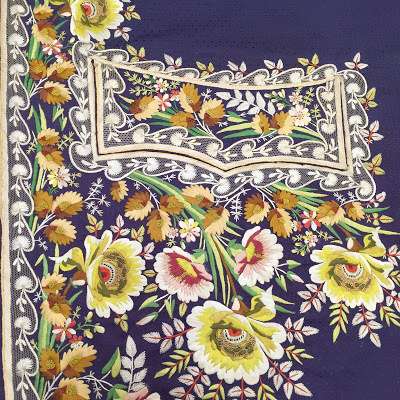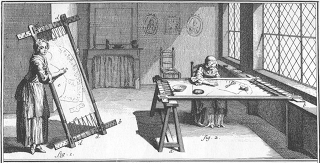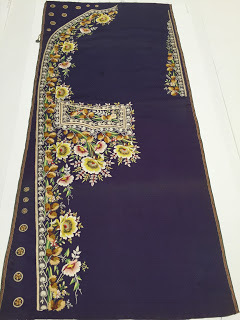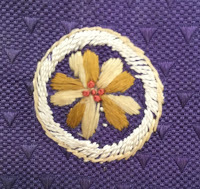Embroidery for a Man's Suit that Was Never Made Up, c1780
 Isabella reported,
Isabella reported,Last month I visited the Metropolitan Museum of Art's Antonio Ratti Textile Center and Reference Library to study examples of 18thc embroidery (see my first post here), including this fascinating example. As always, please click on the images to enlarge them.
This piece is really several pieces, or panels, featuring the embroidered elements for a man's suit that was never completed. Elaborate embroidery was the height of male fashion in the 18thc, and skilled embroiderers executed designs in silk, sequins, and beading.

The embroidery was worked flat, with the fabric stretched taut on wooden frames. The embroidery pattern and the garment's outline were transferred to the fabric via pouncing - a light chalky powder pressed through tiny holes in the paper pattern - and then the lines were reinforced with ink on the fabric. These lines were meant to be covered by the embroidery, although some do still peek through if you look carefully. The illustration from Diderot's Encyclopédie, upper right, shows two embroiderers at work on a coat.

These panels are embroidered in silk thread, with accents of netting, on a purple silk cloth. The larger panel, left, includes not only the embroidery for accenting the front of the coat, but also the pocket flaps, upper left, and buttons, bottom left. The second panel, lower right, has the collar and cuffs as well as the knee tabs for the matching breeches. (To better understand how all these puzzle-pieces were meant to be assembled, see this similar suit, also in the Met's collection.) The pieces that are basted together in the second panel may indicate that different embroiderers were working on the same project.

In most cases, the completed embroidered panels would have next gone to a tailor to be made up into a suit. The embroidery could have been ordered to the tastes of a specific customer, or done on speculation. Either way, it would have been the tailor's responsibility to assemble the embroidery to fit his customer's body.
These panels were never made into finished garments, and the reasons why are now forgotten. They're rare survivors of the historic fashion trades, and wonderful to study as they are. But being a fiction writer, however, I kept wondering why the suit was never made. Were the colors of the silk flowers not to a customer's tastes? Was the embroidery more expensive than he expected, and never claimed? Or was the embroidery somehow "so last year," and out of fashion before it could be finished?
 Many thanks to Melinda Watt, Associate Curator, European Sculpture & Decorate Arts, and Supervising Curator, Antonio Ratti Textile Center, and the staff of the Antonio Ratti Textile Center for their assistance, knowledge, and patience - as you can tell, I had a wonderful Nerdy-History-Girl time!
Many thanks to Melinda Watt, Associate Curator, European Sculpture & Decorate Arts, and Supervising Curator, Antonio Ratti Textile Center, and the staff of the Antonio Ratti Textile Center for their assistance, knowledge, and patience - as you can tell, I had a wonderful Nerdy-History-Girl time!Above: Embroidered panels for a man's suit, French, c1780, Metropolitan Museum of Art. Photographs ©2016 by Susan Holloway Scott.
Published on August 07, 2016 18:58
No comments have been added yet.



